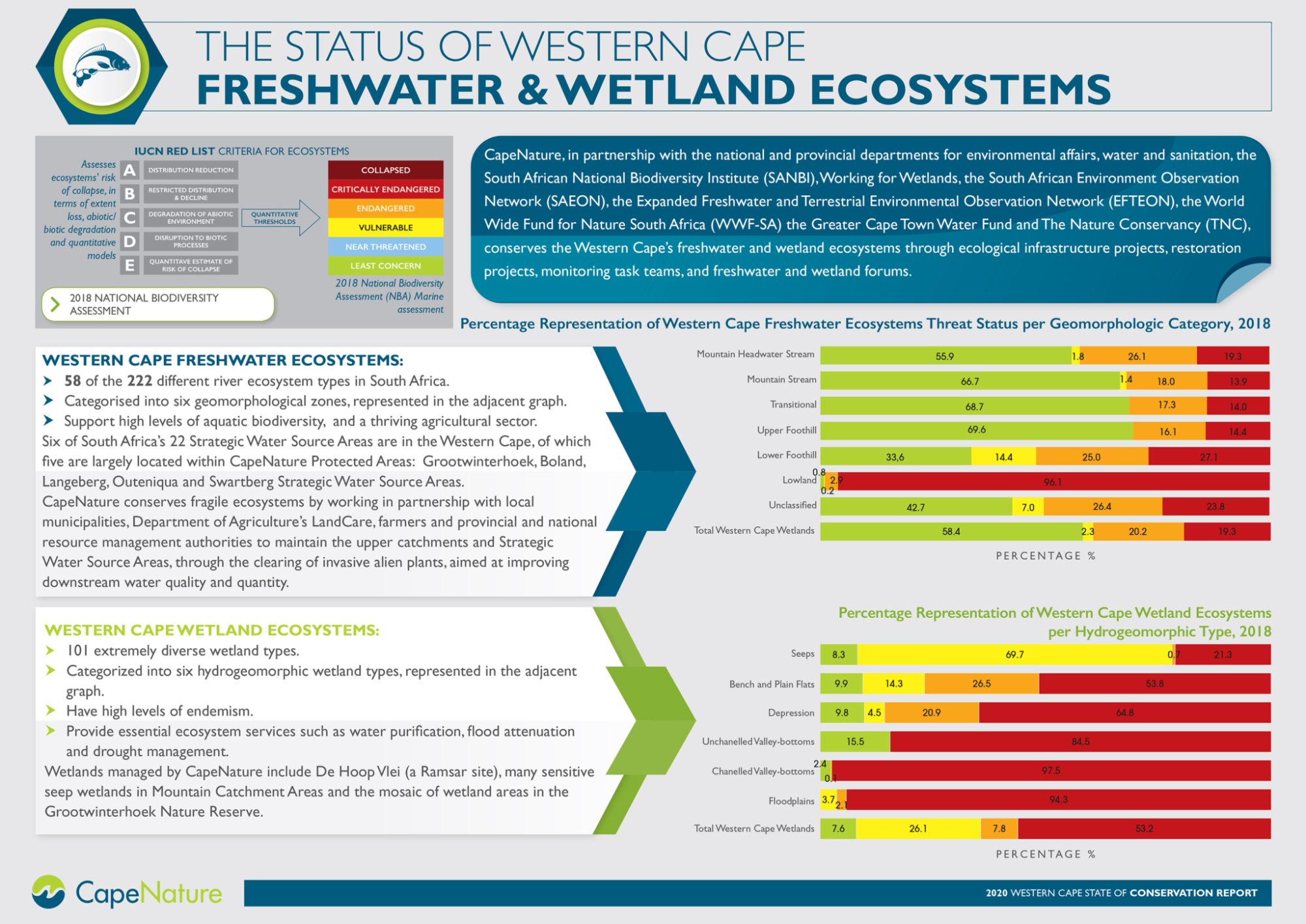Integrated catchment management
Integrated catchment management
Several initiatives have been established to mitigate an increasing impact on the freshwater ecosystems in the Western Cape. Concerning the protection of certain ecosystem services provided by freshwater ecosystems for water provision for instance, focus has shifted to improved and informed management and protection of the strategic water source areas for both ground and surface water. Paired with this are the projects and initiatives associated with the Greater Cape Town Water Fund (The Nature Conservancy, 2018) and other water fund catchments that are being considered.
These projects, together with more established initiatives, are working on the improvement and integration of freshwater ecosystems management in the Western Cape (e.g. Working for Water and Working for Wetlands; the Berg River Improvement Plan). Work towards clearing the water catchments of invasive alien tree species, as well as the rehabilitation of freshwater ecosystems (Western Cape Government, 2012; Western Cape Government, 2017) has received increased attention.
Moreover, the provincial government of the Western Cape has initiated the development of the Ecological Infrastructure Investment Framework (EIIF), which is being developed by the Council for Scientific and Industrial Research. This framework will enable and inform a collaborative and coordinated partnership between the relevant stakeholders, including CapeNature, national and provincial government, tertiary academic institutions as well as non-governmental organisations and the private sector (EIIF REF).
CapeNature ecologists are contributing to a coordinated update of the National Wetlands Map and updates of the Freshwater Ecosystem Priority Area maps (NFEPA; Nel et al., 2011 (a) and (b)). All four major river catchments that form the two water management areas, i.e. the Berg-Olifants and the Breede-Gourits, have undergone water resource classification and the resource quality objectives (RQO) have been set. Efforts are already being undertaken by the provincial Department of Water Affairs and Sanitation and the Breede-Gourits Catchment Management Agency to monitor at least some of the ecological water resource and RQO river sites.
A process to pilot the monitoring of RQO wetland sites in the different catchments has also been initiated and is coordinated by the South African National Biodiversity Institute. The selection of six landscapes in South Africa that will be part of the South African Environment Observation Network (SAEON) and the Expanded Freshwater and Terrestrial Environment Observation Network (SAEON 2020) has recently been initiated. Two freshwater landscapes have been proposed for this project in the Western Cape: the Agulhas plain area and the Boland mountain catchment. It is likely that only one of these will be chosen and CapeNature remains actively involved.

Freshwater and wetlands Ecosystems (State of Conservation Report 2020).
Rivers
The primary riversof the Western Cape are the Berg, Breede, Olifants and Gouritz rivers. Because of the semi-arid nature of the country and increased water demand linked to population growth and increased development, the water resources in the Western Cape are under serious threat. These resources include the rivers, many of which originate in the mountain catchments, often associated with seeps and other wetland types, contributed to by smaller tributaries and flowing down through the foothills to the lowlands and plains and ultimately into the sea via an estuary. Some of these river catchments are highly productive with regards to water provision, i.e. are high water yield.
Seven important water source areas have been identified and mapped for the Western Cape, including Groot Winterhoek, Table Mountain, the Boland mountains, and the Langeberg, Swartberg, Kougaberg and Outeniqua mountains.
Due to regional variation, the rivers of the Western Cape form important habitats for various indigenous fish and other aquatic fauna endemic to the region. Several impacts and pressures threaten the viability and health of river ecosystems, mostly related to land-use practices, the presence of invasive alien fauna and flora and water quality and over-use of water. The tributaries to the main rivers that are free of alien invasive fish species are now the main refuge for the numerous endemic indigenous fish species of the Western Cape.
